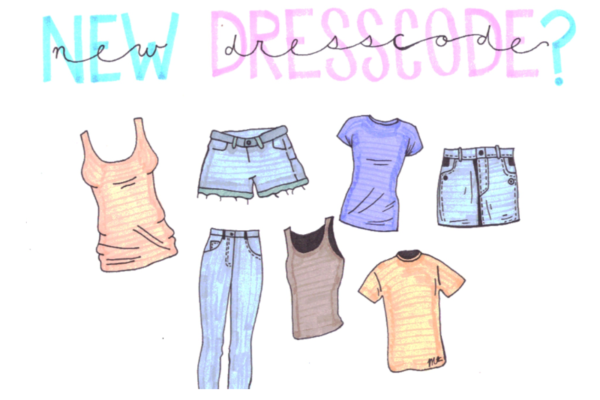He said, she said: dress code in schools
Students’ are taught to express themselves as they grow up and many do this through their choice of clothing, yet many schools implement a dress code to limit what their students wear. So, the question still stands is the dress code fair?

SENIOR ERIC MICHALS believes in his dress code argument from a guy’s prospective. Stay tuned as Michals and Perez debate over more topics regarding ‘teen life’.
He said: Dress code is fair and necessary.
Dress code at schools exists in order to keep the focus in school on learning. Because of this the school system makes the dress code, for guys at least, fair. This code includes no flip-flops, no tank tops that have straps smaller than three fingers, and no shorts that are higher than a student’s fingertip length on the student’s side.
One could debate that the way a student dresses is a form of their expression and students have the right to express themselves in school. Although this is true and many students are brought up learning to express themselves after the supreme court case, Hazelwood School District v. Kuhlmeier in 1988, it was determined that the government has the right to censor students’ rights in school if the actions by the students disrupts the educational environment. This is strictly for the purpose that some clothing garments may be distracting to other students; taking their focus away from their work.
For these reasons dress code is fair and is something that is necessary in every school. Although it does limit students’ rights of expression through what they wear it solely for the purpose of creating a non-distracting educational environment.

SENIOR ALEX PEREZ feels confident after finalizing her argument about dress code from a girl’s prospective. Stay updated with the latest opinions regarding “teen life”.
She said: Dress code should be reformed.
Dress codes at public schools are a somewhat polarizing topic, especially among the female students subjected to them. We all know that dress codes are necessary; after all, school requires some type of standard in students’ appearance to maintain a comfortable learning environment. However, in the age of the #MeToo movement, many believe that dress codes are discriminating against girls. When looked at objectively, female students are not allowed to wear cropped shirts, ripped jeans, tank tops with smaller straps, and even leggings. The reasoning behind this dated dress code is that girls wearing these items will “distract” students, especially their male peers, from their work. Academics may be important, but we have to be mindful of the possibility that the dress codes are unintentionally hurting girls’ self-esteem, which is already not that high as a teenager. When schools body shame girls and force them to cater their clothing choices to how a boy might hypothetically react, they are crossing the line. Because, let’s be honest, I should not have to cover my shoulders for a boy who will get distracted. In actuality, these dress codes normalize the thought process of a stereotypical teenage boy who oversexualizes girls.
There are some schools who are listening to these issues and changing their dress codes as a result. The National Organization for Women created a model dress code that is now used in Portland Public Schools. Clothing may not feature images of drugs, alcohol, obscenities, or gang symbols. Other than that, the only other requirement is that “you have to cover your parts”, but how a student chooses to do so is up to them, Oregon NOW President Lisa Frack said. This way, all students are not punished for expressing themselves which is necessary, especially in the stressful environment of high school.








